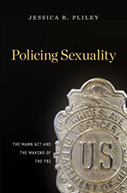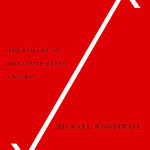Policing Sexuality: The Mann Act and the Making of the FBI

Author: Jessica R. Pliley
Publisher: Cambridge, MA: Harvard University Press, 2014. 304p.
Reviewer: Jim Leitzel | January 2016
The Mann Act, adopted by the US Congress in 1910, responded to a moral panic around the entrapment of women into prostitution. The Act, officially entitled the “White-slave traffic Act,” – James Mann was an Illinois congressman who headed the House committee in which the bill originated – prohibited the transportation of women across state lines "for the purpose of prostitution or debauchery, or for any other immoral purpose." Prostitution control was traditionally the purview of state and local governments in the US, and federal jurisdiction was achieved through the Constitution’s commerce clause – hence the need for the state line condition.
Policing Sexuality uncovers and recounts the story of the lead-up to, and later enforcement of, the Mann Act. The focus is on the federal agency charged with investigating possible Mann Act violations, and the narrative is essentially chronological. The original investigative arm was the Department of Justice’s Bureau of Investigation, which itself was founded only in 1908 and named the Bureau of Investigation (BOI) in 1909, before eventually transforming into the familiar Federal Bureau of Investigation (FBI) in the mid-1930s. The chief source materials for Pliley’s careful and well-written study consist of nearly one thousand case files from BOI and FBI investigations into potential Mann Act offenses between 1910 and 1941 (page 219). (Amazingly, many Mann Act case files from this period remain classified; Pliley suspects that administrative error is to blame (pages 219, 275, note 5)).
The thesis of Policing Sexuality is that the Mann Act served as a major impetus for what became the large national presence of the FBI and helped develop the Bureau’s everyday functioning (page 8). These points are well supported, almost unchallengeable: Mann Act investigations consistently formed a large component of the FBI’s caseload, sometimes the largest component. In the process of establishing her thesis, Pliley provides considerable detail on how Mann Act enforcement changed over the decades, and this detail forms the core of the book.
In the early years, for instance, some agents viewed their job as including the prevention of offenses, so they advised brothel owners and sex workers on how they could avoid Mann Act violations (page 86). In the mid-1930s, alternatively, Mann Act enforcement aimed at post-Prohibition organized crime, with the additional perceived benefit of producing favorable press coverage for the FBI and its head, J. Edgar Hoover, who personally led some Mann Act raids.
Though commercialized, coercive prostitution was the original target of the Mann Act, the “any other immoral purpose” language raised the possibility for the Act to be applied to consensual, non-commercial sex. This possibility rose to the forefront with a 1917 Supreme Court decision which upheld Mann Act convictions for two married men who took their girlfriends on an interstate vacation to Reno that was intended to facilitate divorces for the men. The legal adoption of a broad interpretation of “immoral purpose” allowed the Mann Act to operate “as a federal seduction law, providing parents and victims a tool to use when the bounder who had promised marriage left for another jurisdiction [p. 139].” The broadening of Mann Act jurisdiction into noncommercial domestic disputes was something that long was sought by many citizens: most Mann Act investigations were initiated through private complaints about some actual or perceived sexual impropriety of a family member or someone preying upon a family member (pages 132 and 155). But not all women qualified as victims of this species of seduction; it helped if they were young, white, and of a chaste reputation. By 1940, the FBI largely abandoned the pursuit of cases involving private, non-commercial immorality (page 156).
Both the moral panic and the name of the legislation are indicative of larger social forces that were at work in the enactment and enforcement of the White-slave traffic Act, as Pliley illuminates. The stationing of US soldiers in the Philippines following the Spanish-American War helped to develop concerns with prostitution, with moral crusaders outraged by the US military’s regulatory response to its soldiers’ sex purchases. Later, World War I elevated the pre-penicillin sexually-transmitted diseases of soldiers into a national security concern policed in part by the Department of War, resulting not so much in stricter rules for male soldiers as in harsher treatment for female sex workers: some 30,000 women found themselves in federal custody, with probably a great number in state and local jails (pages 127-128).
The racist nature of the Mann Act went well beyond its official name. African–American victims of commercial vice or black women exploited by white men rarely were viewed as falling within the law’s ambit. White women who were part of mixed-race couples received attention but not aid. “Bureau agents felt compelled to investigate interracial relationships to ensure that men of color were not trafficking white women, but the moment when it became clear that the white women consented to these relationships, then, in the eyes of the Bureau, these women forfeited the protection that the Mann Act offered white women [page 101].” The moral panic that led to the Act frequently identified foreigners as the organizers of sex trafficking. Until 1922, a female US citizen who married a non-white foreigner was stripped of her citizenship; in the case of Asian husbands, the loss-of-citizenship penalty was applied to wives until 1931 (page 102).
The sexual double standard that tolerated pre-marital and extra-marital sex for men but condemned strongly these behaviors for women, making a fetish of female chastity, was a mainstay of Mann Act enforcement – even as society more generally began to back away from the double standard. Male access to purchased sex was not challenged by the Mann Act; instead, the Act was used to bolster traditional husband-headed households and to protect the marriageability of young women.
The fact that Mann Act enforcement did not track changing social mores created a problem for enforcement agents, as they needed to locate a US Attorney who would be willing to prosecute cases – leading to some informal forum shopping (page 220). The BOI agents were investigators and no more: they lacked arrest powers, as well as the privilege of carrying firearms, until 1934 (page 184). Nevertheless, the BOI developed, from modest beginnings, an extensive, nationwide presence and many offenders whose activities violated state laws were referred by BOI officers to local authorities for prosecution (page 104).
The role of citizens in enforcing the Mann Act went well beyond requests for investigations: many of the officials keeping tabs on brothels in the 1910s, for instance, were not Bureau of Investigation full-time employees, but rather part-time local white-slave officers. These officers, typically lawyers or men with criminal justice training, were recruited as deputies of the Bureau of Investigation and issued badges. They were essentially volunteers, despite being paid some meager wages, and they operated in hundreds of US cities. During World War I, the scope of the snooping activities of the local white-slave officers broadened considerably, as they tried to maintain surveillance on potential German sympathizers along with sexually-active women who were viewed as threats to the combat readiness of the soldiers. The officers were aided in their efforts by thousands of additional volunteers whose semi-official activities were organized under the auspices of the American Protective League (pages 124-125), a sort of uncompensated snooping corps.
While the consensual, noncommercial cases look quite retrograde from the perspective of today, the Mann Act offered a tool that could be employed when other levers of justice were not available. In particular, both social pressures and the hard-to-prove element of consent lessened the probability that perpetrators of forcible rape would be charged and convicted in local courts. But consent or lack of consent was immaterial to a Mann Act case, so some rapists were pursued in federal courts for their criminal but non-commercial activity (pages 167-168).
Pliley’s commitment to establishing her thesis concerning the centrality of the Mann Act for the operation and diffusion of the FBI makes Policing Sexuality most appropriate for students of the history of the FBI and federal policing more generally. For readers whose main interest lies in the regulation of sex, David Langum’s Crossing Over the Line: Legislating Morality and the Mann Act (University of Chicago Press, 1994), probably provides the better starting point.
Vice suppression by law was in the air during the Progressive Era, bringing us the (ongoing) prohibition on cocaine and opiates (via the 1914 Harrison Act), national alcohol prohibition (1920-1933), and a suppression of obscene materials sufficiently broad to eventually include Ulysses and the unexpurgated version of Lady Chatterley’s Lover. (U.S. sovereignty over the Philippines helped to spark drug prohibition as well as the Mann Act, in a misguided response to the prevalence of opium use in America’s new territorial acquisition in the early years of the 20th Century.) The constitutionality of the Mann’s Act placing of sexual immorality under federal control was itself cemented by a 1903 Supreme Court case that permitted the criminalization of moving lottery tickets across state lines with the intention of distributing them.
Pornography and gambling have since become widely legal in the US, though the wars on drugs and prostitution continue – and continue to proliferate federal crime fighting power, with thousands of DEA and FBI agents spread out across the United States and in scores of other countries, too. The Mann Act itself, in diluted form and shorn of its offensive original name, remains in place. Pliley suggests that many of the tensions that marked Mann Act enforcement endure: “U.S. trafficking policy is currently antiprostitution, and antiprostitution in practice means antiprostitute, implicating as it does all sex work [page 215, endnote omitted.”] The people that vice laws like the Mann Act are claimed to protect frequently end up victimized by those laws.


